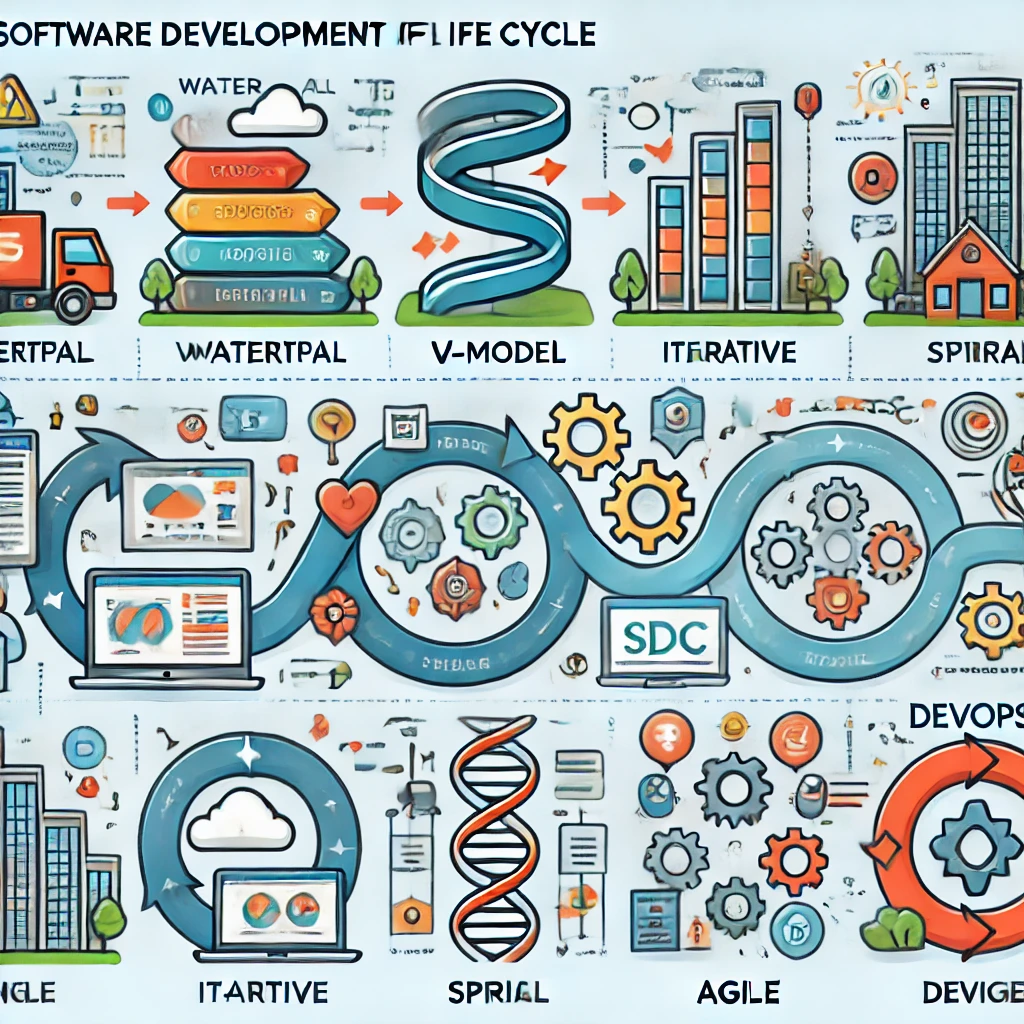SDLC Models: A Quick Guide
 Prasun Dandapat
Prasun Dandapat
In this blog, we’ll explore the most popular SDLC models, their strengths, weaknesses, and when to use each of them.
1. Waterfall Model
The Waterfall model is one of the oldest and most straightforward SDLC models. It follows a linear and sequential approach, meaning that each phase must be completed before moving on to the next one.
Phases:
Requirements Analysis
System Design
Implementation
Testing
Deployment
Maintenance
Pros:
Simple and easy to understand.
Well-suited for smaller projects with clear and fixed requirements.
Easier to manage due to its linear nature.
Cons:
Not flexible; changes in requirements can be costly.
Not suitable for complex projects where requirements are uncertain or likely to change.
Best for: Projects with well-defined requirements and limited changes.
2. V-Model (Verification and Validation Model)
The V-Model, an extension of the Waterfall model, emphasizes verification and validation at each phase of development. It’s also known as the "Validation and Verification" model because each development stage has a corresponding testing phase.
Phases:
Requirements Analysis and System Testing
High-Level Design and Integration Testing
Low-Level Design and Unit Testing
Implementation and System Testing
Pros:
Emphasizes testing early in the process.
Defects are caught and resolved earlier, reducing cost.
Cons:
Similar to Waterfall, it's inflexible to changes.
Not ideal for projects with evolving requirements.
Best for: Projects with a strong emphasis on testing and validation.
3. Iterative Model
In the Iterative Model, software is developed and released in increments or iterations. Each iteration builds on the previous one, incorporating feedback from stakeholders and users.
Phases:
Initial Planning
Iterative Analysis, Design, Implementation, and Testing
Final Deployment
Pros:
Allows partial implementation of the system and incremental improvements.
Defects are easier to identify and resolve.
Customer feedback is incorporated continuously.
Cons:
Requires more resources and skilled professionals.
System architecture can be complex as a result of multiple iterations.
Best for: Large projects where requirements are likely to evolve over time.
4. Spiral Model(Meta Model)
The Spiral Model is risk-driven and combines elements of both iterative and Waterfall models. It allows for iterative refinement through multiple spirals (or phases) of development, addressing risks at each phase.
Phases:
Determine Objectives and Identify Risks
Risk Analysis and Prototype Creation
Design and Development
Testing and Evaluation
Pros:
Focuses on risk management, making it ideal for complex projects.
Flexibility to incorporate changes at each phase.
Cons:
Requires expertise in risk analysis.
Can be costly due to continuous risk assessment.
Best for: High-risk projects or projects with complex requirements.
5. Agile Model
Agile is one of the most popular modern SDLC models. It prioritizes adaptability and customer satisfaction through continuous delivery and collaboration. Agile frameworks like Scrum and Kanban enable frequent releases and iterative development.
Phases:
Requirements Gathering
Planning
Design
Development
Testing
Release and Review
Pros:
Highly flexible and adaptive to change.
Focus on customer collaboration and feedback.
Continuous improvement through regular iterations (sprints).
Cons:
Requires a high level of collaboration and communication.
Can be challenging for larger teams or complex systems without proper coordination.
Best for: Projects where requirements are expected to change frequently, and customer feedback is essential.
Understanding these SDLC models and their application can help project managers, developers, and stakeholders navigate the complexities of software development, ultimately leading to better project outcomes and higher-quality software solutions.
Conclusion
The evolution of SDLC models has provided software engineers with a robust toolkit for tackling various project challenges. Whether it's the traditional Waterfall model, the risk-oriented Spiral model, or the highly collaborative Agile and DevOps methodologies, each SDLC model has its unique place in the software development landscape. Choosing the right model is key to delivering successful software projects that meet business goals and user expectations.
Happy coding and project planning!
Subscribe to my newsletter
Read articles from Prasun Dandapat directly inside your inbox. Subscribe to the newsletter, and don't miss out.
Written by

Prasun Dandapat
Prasun Dandapat
Prasun Dandapat is a Computer Science and Engineering graduate from the Academy of Technology, Hooghly, West Bengal. With a strong interest in AI and Machine Learning, Prasun is also skilled in frontend development and is an aspiring Software Development Engineer (SDE). Passionate about technology and innovation, he constantly seeks opportunities to broaden his expertise and contribute to impactful projects.